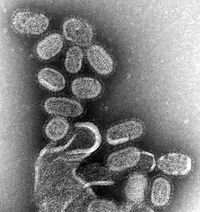
Photo from wikipedia
Bovine respiratory disease (BRD), the leading disease complex in beef cattle production systems, remains highly elusive regarding diagnostics and disease prediction. Previous research has employed cellular and molecular techniques to… Click to show full abstract
Bovine respiratory disease (BRD), the leading disease complex in beef cattle production systems, remains highly elusive regarding diagnostics and disease prediction. Previous research has employed cellular and molecular techniques to describe hematological and gene expression variation that coincides with BRD development. Here, we utilized weighted gene co-expression network analysis (WGCNA) to leverage total gene expression patterns from cattle at arrival and generate hematological and clinical trait associations to describe mechanisms that may predict BRD development. Gene expression counts of previously published RNA-Seq data from 23 cattle (2017; n=11 Healthy, n=12 BRD) were used to construct gene co-expression modules and correlation patterns with complete blood count (CBC) and clinical datasets. Modules were further evaluated for cross-populational preservation of expression with RNA-Seq data from 24 cattle in an independent population (2019; n=12 Healthy, n=12 BRD). Genes within well-preserved modules were subject to functional enrichment analysis for significant Gene Ontology terms and pathways. Genes which possessed high module membership and association with BRD development, regardless of module preservation (“hub genes”), were utilized for protein-protein physical interaction network and clustering analyses. Five well-preserved modules of co-expressed genes were identified. One module (“steelblue”), involved in alpha-beta T-cell complexes and Th2-type immunity, possessed significant correlation with increased erythrocytes, platelets, and BRD development. One module (“purple”), involved in mitochondrial metabolism and rRNA maturation, possessed significant correlation with increased eosinophils, fecal egg count per gram, and weight gain over time. Fifty-two interacting hub genes, stratified into 11 clusters, may possess transient function involved in BRD development not previously described in literature. This study identifies co-expressed genes and coordinated mechanisms associated with BRD, which necessitates further investigation in BRD-prediction research. Author Summary Bovine respiratory disease (BRD), the leading disease in beef cattle, is a highly dynamic disease complex. Through simultaneous sequencing of thousands of genes active in the blood of cattle at arrival, we pursued the co-expression patterns of these genes to evaluate associations with BRD development and severity overtime. This approach allows for a better understanding of gene expression active in cattle at arrival, and the discovery of new molecules and biological complexes that may predict BRD before the onset of clinical signs. Our work provides evidence that genes related to T-cells, a type of immune cell, are strongly co-expressed when cattle arrive to beef production system, and correlate with increased red blood cell (RBC) factors and BRD development. Further analysis shows that genes involved in cellular energy production and the respiratory electron transport are strongly co-expressed when cattle arrive to beef production system, and correlate with increased eosinophils, a type of immune cell, and weight gain overtime. Additionally, using genes which strongly correlate with BRD development and severity overtime, we identify a novel protein interaction complex that may drive future research for discovering new ways to manage and treat BRD in beef cattle.
Journal Title: PLOS ONE
Year Published: 2022
Link to full text (if available)
Share on Social Media: Sign Up to like & get
recommendations!